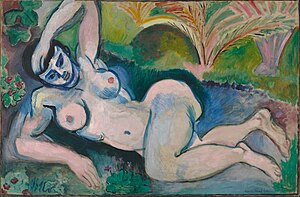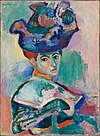User:Mango lassi/sandbox
 | This is a user sandbox of Mango lassi. You can use it for testing or practicing edits. This is not the sandbox where you should draft your assigned article for a dashboard.wikiedu.org course. To find the right sandbox for your assignment, visit your Dashboard course page and follow the Sandbox Draft link for your assigned article in the My Articles section. |
| Blue Nude (Souvenir de Biskra) | |
|---|---|
 | |
| Artist | Henri Matisse |
| Year | 1907 |
| Type | Oil on canvas |
| Dimensions | 92.1 cm × 140.3 cm (36.3 in × 55.2 in) |
| Location | Baltimore Museum of Art, Baltimore, Maryland, United States |
Blue Nude (Souvenir of Biskra) ("Nu bleu, Souvenir de Biskra"), an early 1907 oil painting on canvas by Henri Matisse, is located at the Baltimore Museum of Art as part of the Cone Collection.[1]
Matisse painted the nude when a sculpture he was working on shattered. He later finished the sculpture which is entitled Reclining Nude I (Aurore).
Matisse shocked the French public at the 1907 Société des Artistes Indépendants when he exhibited Blue Nude (Souvenir de Biskra). The Blue Nude was one of the paintings that would later create an international sensation at the Armory Show of 1913 in New York City.[2]
The painting, which may be classified as Fauvist, was controversial; it was burned in effigy in 1913 at the Armory Show in Chicago, to where it had toured from New York. In 1907 the painting had a strong effect on Georges Braque and Pablo Picasso, partially motivating Picasso to create Les Demoiselles D'Avignon.[3]
Matisse made three trips to North Africa. The first trip in 1906, was to Biskra, Algeria, and in 1912 and 1913, he traveled to Tangier, Morocco, where he stayed for months each time.[4] Before traveling to Biskra, Matisse visited the National Colonial Exposition of Marseille, which was one of several universal fairs during the nineteenth century, which was known as the century of universal exhibitions. In France, the colonial experience was a major part of the exhibitions, in which indigenous peoples from colonized countries were brought to France as part of panoramic display in temporary villages. This display of nationhood had a correlation with official traveling scholarships that enabled young artists to go abroad in search of Orientalist themes to paint. This state sanctioned art was another way that the Mission Civilisatrice was promoted. Although Matisse benefitted from the relatively easy and secure system of travel that had been set up from France to the colony of Algeria, he operated outside of the traveling scholarship system, as he was a successful artist who had wealthy patrons.
Blue Nude had two previous titles. For the 1907 exhibition at the Salon des Independants in Paris, the painting was titled Picture III, (Tableau III). In 1920, the work was published under the title Odalesque, which is a term that relates to female availability, and to prostitution. In Biskra, women of the Ouled-Nail tribe were a fixture in the oasis town. They were often belly-dancers who were allowed to engage in the prostitution trade without retribution. In letters to his friend Henri Manguin, Matisse references the Ouled-Nail bellydancers, "As for belly-dancing, I didn't even bother to look for it in Algiers, and I saw it by chance for a quarter of an hour in Biskra. The famous Ouled-Naild, that joke? One has seen it a hundred times better at the Exposition." Matisse was well aware of the women of Ouled-Nail tribes, and Roger Benjamin surmises in Orientalist Aesthetics, that there is a possibility that Matisse may have hired a woman of the Ouled-Nail tribe, whether for sexual gratification or for modeling, or both.

When Blue Nude was exhibited soon after it was painted, it became the source of controversy that involved issues of race, race relations, and colonialism. Complaints by critics and viewers that the race of the figure in Blue Nude could not be identified, complicated the issue of "the Self." The ability to identify "the Other" was crucial to the mindset of colonizers, and a major aspect of the colonization program.[5]
See also
References
[edit]- ^ Baltimore Museum of Art, Henri Matisse, Blue Nude (Souvenir of Biskra)
- ^ "Matisse, Henri." Encyclopædia Britannica Online, 2007. Retrieved 30 July 2007
- ^ Tyler Green, Modern Art Notes, The Response to Matisse's Blue Nude
- ^ Benjamin, Roger (2003). Orientalist Aesthetics: Art, Colonialism, and French North Africa, 1880-1930. Berkeley, California: University of California Press. pp. p.161. ISBN ND1460.E95 B46.
{{cite book}}:|pages=has extra text (help); Check|isbn=value: invalid character (help) - ^ Wright, Alastair (2005). Matisse and the Subject of Modernism. Princeton, New Jersey: Princeton University Press. pp. 163–191. ISBN 978-0691118307.
External links
[edit]Category:Post-impressionist paintings Category:Fauvism Category:1907 paintings Category:Nude art Category:Paintings by Henri Matisse Category:Paintings in Baltimore

